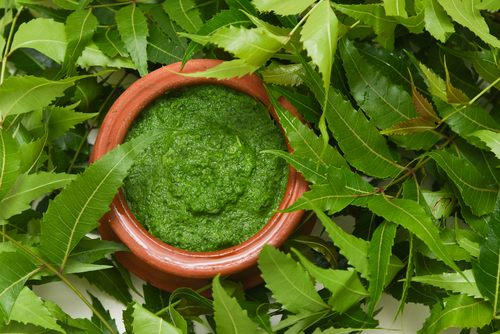
What is neem? Neem is the common name for Azadirachta Indica. It is also called Indian Lilac. It is a fast-growing and long-living tree. The neem tree can reach heights of 130 feet but averages about 65 feet. The fruit of the neem plant looks very like an olive. Its seeds contain one or several kernels.
Ingesting neem provides many health benefits. During this critical time of the coronavirus pandemic, it is especially important to strengthen our immune system and our bodies. Healthy systems enable us to fight off diseases quicker and more efficiently. Neem can help us do that.
Sadhguru looks at the many medicinal benefits and uses of neem leaves, a versatile natural product that can be used beneficially on the skin, against cancer and bacteria, and in yogic sadhana.
#1 Anti-cancer benefits of neem
Neem has many incredible medicinal benefits, but one of the most important things is, it kills cancerous cells. Everyone has cancerous cells in their body, but normally, they are disorganized. However, if you create certain situations in the body, they will get organized. As long as these cells are loafing around by themselves, it is not an issue. If they all gather in one place and hit it off, it becomes a problem. This is like a shift from petty crime to organized crime. It is a serious problem. If you consume neem every day, it keeps the number of cancerous cells in the body within a certain limit, so that they will not gang up against your system.
#2 Anti-bacterial benefits of neem
The world is full of bacteria. So is the body. There are more microorganisms living in you than you can imagine. Most of these bacteria are helpful. Without them, you would not be able to digest anything. In fact, you cannot exist without them. But some bacteria can cause you trouble. Your body constantly spends energy to manage these bacteria. If excess levels of bacteria occur, you will feel “down” because your defense mechanism has to spend too much energy to fight them. By using neem internally and externally, you can manage these bacteria in such a way that they will not overgrow, and your body will not have to spend too much energy in fighting them. If you consume a certain amount of neem on a daily basis, it will destroy the troublesome bacteria in the intestinal region, and your colon will generally remain clean and free of infection.
Also, if there is a slight smell in certain areas of the body, it means bacteria are a little more active there. Almost everyone has some minor skin issues but if you wash your body with neem, it becomes clean and radiant. If you rub your body with neem paste before having a bath, let it dry for some time, and then wash it off with water, it will act as a good antibacterial cleanser. Alternatively, you can soak a few neem leaves in water overnight and bathe with this water in the morning.
#3 Benefits of neem for yogic sadhana
Above all, neem generates heat in the body. This generation of heat is supportive for generating intense forms of energy within the system. Different qualities can be predominant in the body – two of these are sheeta and ushna, in traditional terms. The closest word for “sheeta” in English is “cold,” but that is not exactly what it is. If your system moves towards sheeta, the mucus levels in the body will go up. Excess mucus in the system is linked to a variety of conditions, from the common cold and sinusitis to many other issues.
For a hatha yogi, neem is particularly important because it keeps the body slightly oriented towards ushna. Ushna means you have some extra “fuel”. For a sadhaka who explores unknown terrain, it is safer to carry an extra can of fuel, just in case your system needs that extra power. You want to keep the fire slightly higher than generally needed. If the body is in a condition of sheeta, you will not be capable of too much activity. But if you keep your body slightly on the ushna side, even if you travel, eat outside, or are exposed to whatever else, this extra fire in you will burn and handle these external influences. Neem is a big support in that direction.
Things to keep in mind
One thing to keep in mind is, when consumed in excess, neem will kill sperm cells. In the first four to five months of pregnancy, when the fetus is developing, pregnant women should not have neem. Neem does not cause any damage to the ovaries, but it causes excess heat. When a woman has just conceived and there is too much heat in the body, she may lose the fetus. If a woman is planning to conceive, she should not consume neem because there will be excess heat, and the system will treat the baby like a foreign body.
If heat increases, certain changes will happen in the system – women will notice this more than men. In case this affects the normal process of the body, we bring the heat down to some extent, but we generally do not want to give up neem because for people who do sadhana, some amount of heat in the system is needed. Once they begin to have neem on a daily basis, some women may find that their menstrual cycles become shorter. In that case, just drink more water. If having more water alone is not sufficient to reduce the heat, add a piece of lemon or the juice of half a lemon to the water. If that is still not enough, have a glass of ash gourd juice, which is very cooling. Another option is castor oil. If you put some of it into your navel, at your anahata, at the pit of the throat, and behind the ears, it will instantly cool the system.




